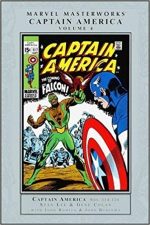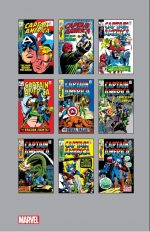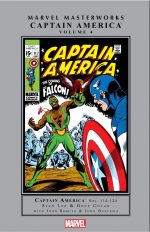


By Stan Lee, Gene Colan, John Romita Sr., John Buscema & various (Marvel)
ISBN: 978-0-7851-2936-3 (HB)
During the Marvel Renaissance of the early 1960’s Stan Lee & Jack Kirby tried a tactic that had reaped huge dividends for DC Comics. Although initially generating mixed results, their efforts eventually changed the nature of comicbooks. Julie Schwartz had scored an incredible success with his revised versions of the company’s Golden Age greats, so it seemed natural to try and revive the characters that had dominated Timely/Atlas in those halcyon days.
A new Human Torch had premiered as part of the revolutionary Fantastic Four, and in the fourth issue of that title the Sub-Mariner resurfaced after a 20-year amnesiac hiatus (everyone concerned had apparently forgotten the first abortive attempt to revive an “Atlas†superhero line in the mid-1950s).
The Torch was promptly given his own solo feature in Strange Tales from issue #101 on and in #114 the flaming teen fought an acrobat pretending to be Captain America. With reader-reaction strong, the real thing promptly resurfaced in Avengers #4 and, after a captivating and centre-stage-hogging run in that title, was granted his own series as half of the “split-book†Tales of Suspense with #59 (cover-dated November 1964). An unmissable string of classics ensued and in 1968 the Star-Spangled Avenger won his own solo title… but not for long…
This groundbreaking full-colour compilation (available in hardback and digital editions) gathers Captain America #114-124 – spanning June 1969 to September 1970 – and opens with a captivating Introduction from illustrator Gene Colan revealing amongst other things how he created The Falcon…
The comics portion of this treat opens as the Sentinel of Liberty has just acrimoniously retired from superhero service and reclaimed his anonymity after impetuously revealing his secret identity to the world mere months earlier.
The hiatus doesn’t last long as, again a man of mystery, Captain America bursts into action to save his lover Sharon Carter (SHIELD Agent 13) from a suicide mission against Advanced Idea Mechanics.
The tale coincided with an ongoing period of artistic instability as here John Romita the Elder (inked by Sal Buscema) illustrated Stan Lee’s tense spy-caper ‘The Man Behind the Mask!’.
The action and suspense were merely prologue to an extended war against the Red Skull. Issue #115 – ‘Now Begins the Nightmare!’ – was drawn by John Buscema and inked by his brother Sal, wherein the fascist arch-villain uses the reality-warping Cosmic Cube to switch bodies with the shield-slinger and trash the hero’s reputation, after which ‘Far Worse than Death!’ in #116 follows Cap’s frantic attempts to escape his own friends and allies the Avengers, as well as the villain’s callous reality-warping torments.
This issue saw the start of Gene Colan’s impressive run on the character, here augmented by the smooth, slick inks of Joe Sinnott.
This next instalment returns him to the Isle – and clutches – of aging war criminals the Exiles in a tale that introduced Marvel’s second black superhero.
‘The Coming of … the Falcon!’ in issue #117 was a terse, taut build-up to a cataclysmic clash before the neophyte hero-in-training takes centre-stage in ‘The Falcon Fights On!’ after which all the ducks drop neatly into place for a spectacular finale in ‘Now Falls the Skull!‘ in #119.
As 1970 dawned, Marvel imposed a moratorium on continued stories for most of their titles, and Cap – having returned to his hectic twin lives as unofficial SHIELD Agent and mighty Avenger – here hops on the disaffected youth/teen revolt bandwagon for a series of slight but highly readable puff-pieces promising nothing but delivering much.
Kicking off is ‘Crack-up on Campus!’ by Lee, Colan & Sinnott: an odd mélange of student radicalism and espionage that sees itinerant cipher Steve Rogers become a Physical Education teacher to foil a scheme by the sinister cyborg Modok and his AIM cohorts.
Demented bio-chemist Silas X. Cragg then rediscovers the fabled Super Soldier serum that had originally created Captain America in ‘The Coming of the Man-Brute!’ Sadly, the bonkers boffin picks the wrong candidate to become his Blockbuster stooge…
Spider-Man’s old sparring partner mugs the wrong guy in #122’s ‘The Sting of the Scorpion!’ and subsequently falls to Cap’s bludgeoning fists before issue #123 taps into the seemingly eternal “battle of the sexes†zeitgeist with ‘Suprema, The Deadliest of the Species!’ turning her espionage-tinged attentions to the Star-Spangled Avenger…
The blazing battle action then concludes here as AIM returns with a deadly new hi-tech human weapon. Despite all their efforts the Sentinel of Liberty triumphs yet again in ‘Mission: Stop the Cyborg!’…
Supplementing the drama is Romita’s original art cover for #114s and its colour roughs.
These are tales of dauntless courage and unmatchable adventure, fast-paced and superbly illustrated, which rightly returned Captain America to the heights that his Golden Age compatriots the Human Torch and the Sub-Mariner never regained. They are pure escapist magic. Glorious treats for the eternally young at heart, these are episodes of sheer visual dynamite that cannot be slighted and should not be missed.
© 1969, 1970, 2016 Marvel Characters, Inc. All rights reserved.

Although John Romita senior, Sal Buscema, Joe Sinnott and Gene Colan are a legendary quartet of giants in the industry, the trouble with this volume is that (a) it never does a title any favours to use a mix of artists, because any title benefits from the consistent visual style of one man, and (b) Stan was throwing these guys to the wolves by asking them to follow Jack Kirby.
Kirby had been drawing this character since – literally – the Golden Age, and (even worse) at this point was at the height of his powers. Jack _was_ Marvel. His style was the house style. And everything he touched turned to gold. If there was such a thing as a “golden rule” in the industry, it was surely: you can’t follow Kirby!
This volume shows why: like the X-Men before it, the Captain America title immediately lost its way when Jack was taken off it, and the title never recovered — until Kirby returned to it in 1976! The insane notion that Jack Kirby was only drawing it, that you could substitute another artist and the plotting wouldn’t suffer, is here shown up as the fallacy it surely was, just as had already happened on the X-Men. Without Kirby’s genius driving the plot, the “Marvel method”, whereby the writer and penciller collaborated on the storyline (and the writer’s only genuine contribution was the dialogue, not the plot itself), was only marginally effective.
The explosion of new titles being published by Martin Goodman after 1968 meant that Stan and Jack could no longer control every Marvel title, and in consequence the quality suffered: too much product spread the company’s talent too thin, and it was set on a rocky downhill road back toward the monster mags and horror mags of the Fifties: in the Seventies turning out Dracula, Swamp Thing, Ghost Rider … and Howard the Duck. To name but a few.
As a publisher, Goodman’s pile-’em-high sell-’em’-cheap philosophy had been hamstrung for a few brief but glorious years in the Sixties, to the great benefit of Marvel; but in finally breaking out of the distribution contract which Goodman had hated, but which had done Stan and Jack such a huge favour, Goodman was killing the goose that laid the golden egg: Stan and Jack were the brightest talent in the industry, but Captain America was an illustration of the basic truth that they could not maintain the high quality of the preceding decade in the face of a doubling and tripling in the number of titles being published each month.